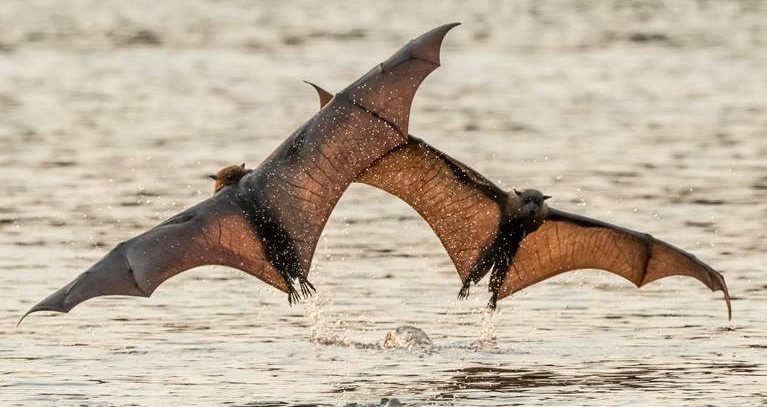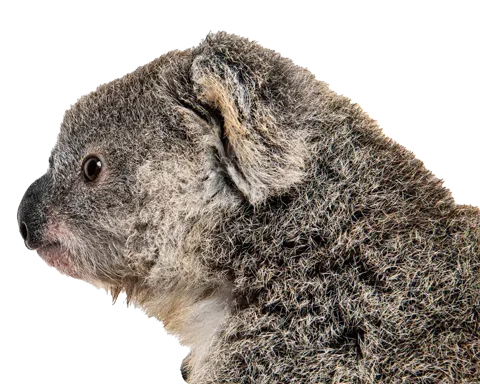Sydney’s ubiquitous Grey-Headed Flying Fox (GHFF) is Australia’s largest flying fox species and, although apparently common, it was added to the Threatened Species Lists in 2001 as ‘Vulnerable to extinction’. Although surprising to many, it was well-justified based on population trends, when a decade of study revealed a 30% population drop. This information is of serious concern for the survival of the species – and the survival of our native forests, ecosystems and overall biodiversity.
Not all ‘threatened species’ are rare and population trends can warn us that intervention is required to prevent extinction occurring; especially with species that have a low reproduction rate. Flying Foxes (FFs) are cursed with the double-whammy of low fecundity and high mortality – meaning they can’t easily recover from either sudden population drops or from a gradual and continued downward population trend. Both are happening to FFs as a result of extensive clearing of habitat and consequent reduction in food resources; camp disturbances; increased severity and frequency of storms and droughts; and increased temperature spikes over 40 degrees.
Estimates indicate the GHFF population is only 5% of what it was prior to European settlement and, if recent declines continue, the species could be “effectively extinct” by the middle of this century. A species is effectively extinct when there are not enough animals left in the wild to perform their ecological role effectively.
But what is their ‘ecological role’? It is to pollinate our eucalypts and other native hardwoods which are the pioneer tree species that form the scaffolding of our native forests. These trees form the microclimates that create the habitats required for tens of thousands of other native species to survive.
Contrary to primary school biology, not all pollinators are birds, bees and butterflies and many of our native trees have evolved to ensure they are only pollinated at night. As FFs are the only significant nocturnal pollinators, they are designated as a ‘keystone species’ – a specialised and irreplaceable species performing a unique role. FFs can typically fly 50-100kms a night to forage and consequently are the only species that can disperse seed, pollinate trees, and spread genetic material across a landscape scale – all essential to ensure our native forests are genetically robust and capable of surviving climate change and disease. If we lose these wonderful animals we will, gradually but eventually, lose our native forests.

The symbiotic mechanism is between FFs and our forest hardwoods is simple. Flowers are only pollinated by fresh pollen, which is only produced at night. To attract FFs, the trees also produce their main nectar load at night. The flowers of these hardwood trees are predominantly held above the canopy at the end of branches and are either cream or white – all adaptations to ensure they will attract a winged, nocturnal pollinator.
The recent drought, bushfires and extreme temperatures have been devastating to this season’s FF pups –generally born in spring and early summer. It seems likely that the only significant food available to FFs in Sydney at the moment is the native figs in public parks and on nature strips. If these crops persist until rain, Sydney may avoid a massive FF starvation event.
- Trees that are seriously drought-stressed stay alive by withholding the last of their precious moisture and produce flowers that have no nectar – which is the main diet of FFs.
- Hot temperatures evaporate any nectar that is produced, making it unavailable to nectivores.
- A serious lack of nectar across large areas has resulted in adult FF’s abandoning camps to avoid
- starvation, leaving the dependent pups alone to starve as they are still too young to fly, This is rare, but has occurred in at least six camps so far this year resulting in the deaths of thousands of pups in western Sydney (Windsor) as well as the Shoalhaven and the Hunter.
- Additionally, temperatures over 42 degrees can cause a whole camp of FFs to collapse, with thousands dying in one day. We’ve already seen numerous days over this threshold temperature in several areas, up to 45 degrees in some camps. Temps of 45 degrees are again being forecast in western Sydney as I write this article.
- Fires so far this year have destroyed over four million hectares of native forest, removing essential food sources for FFs and many other native species. Some areas have seen such huge fires we may find a ‘migration bottleneck’ forms, as the fireground has no food and is too large for migrating species to cross without sustenance or shelter.
- A lack of natural food triggers an upswing in deaths and rescues of FFs from foraging for backyard fruit and being entangled in ‘death trap’ fruit tree netting. ‘Netting season’ is about to start and there can be up to 20 netting rescues broadcast each day. Most animals entangled are seriously injured and many need to be euthanised. This includes many lactating others, meaning a dependent pup left in a camp will slowly starve to death.

The situation is horrendous. FF carers across all NSW are overloaded, well past care capacity and exhausted both physically and mentally. Additionally, as FFs are highly intelligent and incredibly affectionate, there is a highly personal impact on the emotional wellbeing of carers who are witnessing so much death.
It was recently feared that some 150 viable pups would need to be euthanised in the Shoalhaven due to lack of care capacity but, at the last minute, a private plane was arranged (for the cost of fuel) to deliver orphaned pups from the Shoalhaven to Queensland where there was some spare care capacity.
What can we do? We can all do something – here are my suggestions:
- Volunteer regularly at the Rescue Office or on after hours phones if you can, so that exhausted carers can spend more time at home - either caring for their animals or trying to recover from exhaustion. This should be considered every spring and summer when carers are most likely to be overloaded.
- Ask your Branch FF Coordinator if you can assist carers in any way. Even shopping, cooking, washing – not necessarily hands-on FF care.
- Volunteer at Kukundi FF Aviary (near the Lane Cove Rescue Office) when help is needed during creche season, especially with fruit chopping.
- Ask people with ‘death trap’ netting over their home fruit trees to either remove it or replace it with wildlife friendly netting. FFs and other wildlife species (including birds, possums, lizards and snakes) can be caught in the poorly-designed, wide-gauge netting that causes excruciating injuries and death. If you are not comfortable speaking to them personally then print off a brochure and pop it in the letterbox with a polite handwritten note (so they know it’s not junk mail). https://www.wildlifefriendlyfencing.com/WFF/Netting.html
- Water street trees or park trees (with a bucket and a soil-wetting agent), especially if they are flowering natives or have a heavy crop of native figs. Do NOT fertilise a stressed tree. These trees are keeping Sydney’s FFs (and many other species) alive. Water around the drip line under the outer edge of the leaf canopy if they are large trees and try to soak the soil in at least one spot, rather than providing superficial water around the entire tree. Not all figs crop at the same time so check each tree. High numbers of foraging FFs indicate abundant fruit. The most common native species are Hills figs, Weeping Figs, and the Port Jackson and Morton Bay figs. I’ve saved several young verge box trees with just three litres of water a day for several days, then three litres twice a week. This will keep it alive until rain arrives.
- Give your Council a list of native street and park trees producing FF food and street trees that are about to die and ask them to introduce emergency support-watering. Send them this article, to explain the background to the request. Right now, the most important are the large native figs with a heavy crop of ripe figs and those with a heavy crop of green figs.
- Watering street trees may also save injury to people and damage to cars because drought-stressed trees start to drop branches, some of them quite large.
- Write to politicians - be firm but polite. Ask for urgent action on climate change and for an urgent moratorium on the clearing of native vegetation, especially given the impact of the recent bushfires.
- When politicians say they support positive action on these issues email them (and their boss!) saying you support their stand (eg the NSW Minister for the Environment, Matt Kean on April 5 and Dec 10, 2019).
- Suggest to politicians and newspapers that volunteer wildlife carers who have taken time off work deserve the same financial support that has recently been extended to volunteers in the Rural Fire Service.





